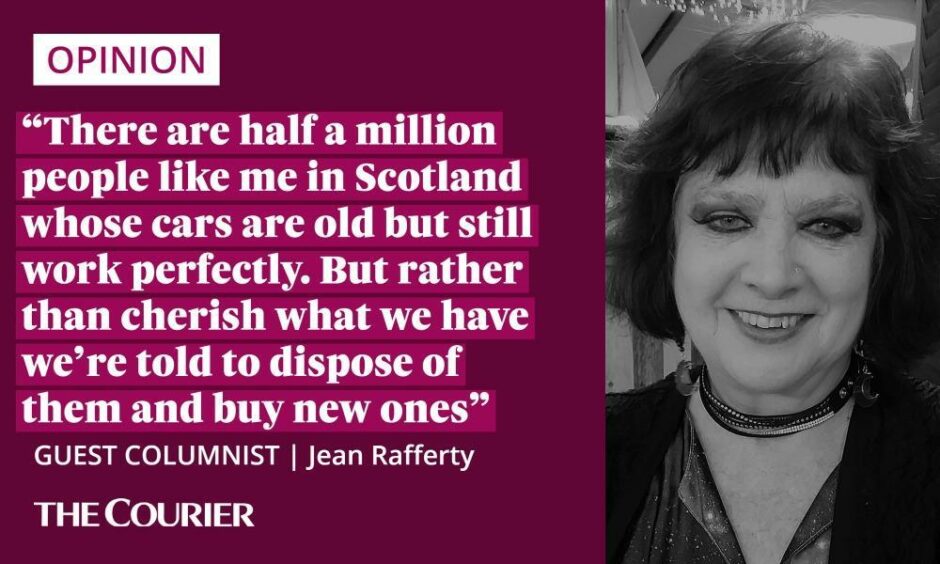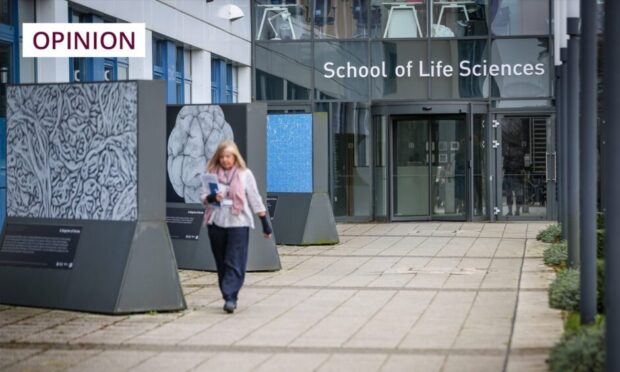My Honda Jazz is what’s politely termed an old banger.
There’s a scrape down the side where I backed too close to a wall, the central locking’s stopped working, and to get into the boot I have to pull the back seat down and clamber over.
But it hums along like a wee bird and I love it. Especially because my mother gave it to me.
There were only two requirements, that it be red (for me) and that the boot be big enough to take a wheelchair (for her).
It was made in 2005 and being a Honda it will probably run till 2050.
My mother and my car gave me my freedom. And now the politicians are trying to take it away – in the name of a spurious environmentalism that makes no sense at all.

Low Emission Zones are being introduced this spring in Dundee, Aberdeen, Glasgow and Edinburgh.
The Dundee one is due to be launched in May although there will be a two-year grace period before the first fines are dished out to those of us with polluting vehicles.
But when enforcement starts in 2024, people with cars which are too old or have high emissions will be fined £60 for coming into the city centre.
Meanwhile, those who can pay 30 grand for an electric one or three times that for a spiffy new Porsche will be free to swan about wherever they like.
The logic escapes me.
Classic cars can last a lifetime
Essentially it means someone whose car has years of life left in it has fewer rights than someone who ditches a perfectly serviceable one.
But in all the assessments of environmental damage, why is the cost of creating new vehicles not factored in?
Especially as it doesn’t have to be this way.
In Havana glowing fuschia and purple and red vintage cars stand proud next to the brightly painted colonial buildings.
There are around 60,000 classic cars in Cuba, a quarter dating as far back as the 1930s.
When Fidel Castro banned the import of American cars, the Cubans lovingly nurtured those they had.
Now they’re a joy for tourists.
The environmental cost of creating new cars all the time is colossal, not least to those who provide the raw materials.
But they live on the other side of the world so what do we care?
Impact of batteries for electric cars
The remote Obi Island has one of the largest nickel mines in Indonesia – nickel being one of the key components of batteries for electric vehicles.
Since the arrival of the mining companies it also has a rate of deadly respiratory infections more than double that of Indonesia as a whole.
The drinking water is unsafe, with high levels of the carcinogenic chemical, hexavalent chromium.
And the sea, once clear and sparkling, is red and muddy.
Before, the villagers could fish outside their houses.
Now local fishermen are out at sea for three days at a time because their traditional grounds are so depleted.
But the price of nickel has been hitting all-time highs, so what do we care?
Cobalt value is rising, but at what cost?
Demand for cobalt, another valuable mineral used in EV batteries, is estimated to rise by 585% over the next 30 years, but in Congo, where two thirds of the world’s supply is mined, workers are paid as little as 30 pence an hour.
They work deep underground, trying to extract the ore with old-fashioned picks and hammers instead of pneumatic drills.
Safety measures are derisory – often they don’t even have hard hats to protect them from falling debris.
cobalt is primarily used in the manufacture of lithium-ion batteries & is mined using child slavery in Congo
the primary ores of cobalt always contain arsenic. this is nothing short of criminal & is orchestrated by corporations that manufacture & market electric cars, etc….. pic.twitter.com/dErZ3Jie8m— michael (@fardos) April 10, 2022
All in the name of salving the conscience of the West.
And making huge profits for shareholders.
The cobalt industry made 6.79 billion dollars in 2018. Multiply that by nearly 600% and it’s dizzying.
Electric cars and other wasteful trends
What kind of environmentalism operates by throwing away what we have and constantly starting again?
It’s like fast fashion, grabbing the latest trend without a thought, morality as disposable as the frocks.
Nicola Sturgeon has staked her environmental credentials on wind turbines.
But drive down the M74 and you’ll see half of them turned off, often because the grid can’t take it. Every time they are, customers have to pay.
The energy companies made £4,652,623 during Storm Franklin, because there was too much wind.
But rather than consider we might actually have more windfarms than we need, the Scottish Government continues to drive a tank through local opposition.
In the Highlands alone it has over-ridden objections 40 times in the last five years.
In 2017 we were promised a national energy company.
Instead we’ve seen the contracts for offshore windfarms go to private firms.
The SNP’s big battle cry used to be “It’s oor oil”. But oor wind now belongs to Japan and France and the turbines are manufactured a world away and dragged here by tug.
There are half a million people like me in Scotland whose cars are old but still work perfectly.
But the sale of new petrol and diesel cars and vans will be phased out by 2032, eight years ahead of the deadline south of the border.
And the advent of LEZ zones next month means parts of the country will be out of bounds to us, unless we can afford to fork out £60 a time for the privilege.
Rather than cherish what we have we’re being told to dispose of them and buy new ones.
Still, the electric car industry will be worth 170 billion dollars by 2026 so what do we care?
Jean Rafferty is an award winning journalist, and the author of five books, including Ladies of the Court and The Cruel Game.













